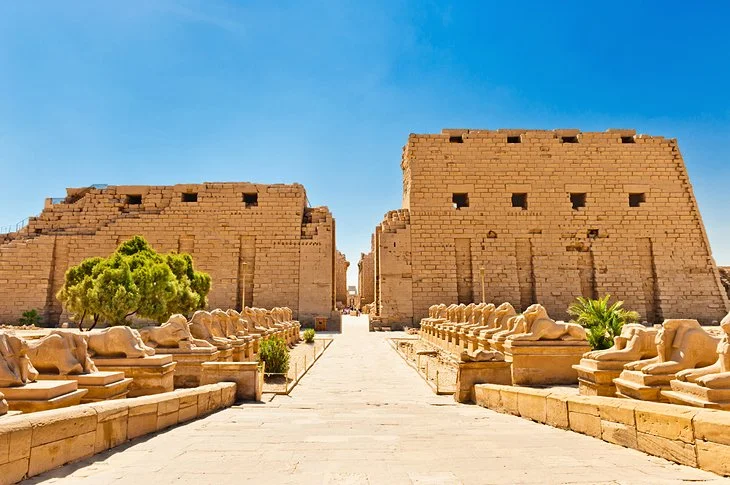Marsa Alam to Luxor
Take an exclusive day trip to Marsa Alam to Luxor -the largest open-air museum.
Enjoy a relaxing trip in your car with a professional guide, and visit many of the well-known tombs and temples in Egypt.
Take a stroll through the Valley of the Kings, visit the magnificent Karnak Temple, enjoy a delicious meal, and then see how local artists create stunning stone sculptures.
This unique experience is available every day and is included in all hotels, starting from El Quseir to Port Ghalib with the possibility of a fee if you’re staying further to the south.
If you’re fluent in English, Italian, German, Dutch, Polish, or French, we’ve covered you
Get up early for work at 4 am, and the reward is worth it.
Places You Will Visit on Marsa Alam to Luxor Trip
Valley of the Kings
The Valley of the Kings is Necropolis along the western bank of Nile River, near Luxor in Egypt There were pharaohs as well as powerful nobles from The New Kingdom were buried.
It’s also home to over 60 tombs cut from rock, including the tombs from Tutankhamun, Ramesses VI, and Thutmose III.
Visit the tombs and royal burial sites of the great Pharaohs.
The tickets include three of the finest tombs:
- Ramses I
- Ramses III
- Ramses IV
Extra cost If you want to visit Ramses V, Seti I or Tutankhamun.

Hatshepsut Temple or Medinat Habu Temple
You can pick one of these gorgeous temples:
Hatshepsut Temple
This stunningly beautiful Hatshepsut Temple is referred to as Djeser-Djeseru.
It was built to honour the Eighteenth Dynasty “Pharaoh Queen Hatshepsut”.
It is among the most impressive temples in ancient Egypt and is believed to be among the most important ancient Egyptian accomplishments.
This temple was dedicated to Hatshepsut as well as Amun.
The Egyptian monarch was required to honour their gods and Pharaohs and preserve their memories to the end of time through the building of temples and tombs.
Queen Hatshepsut was constantly aware of ways to improve public appearance and make her immortal.
The Mortuary temple accomplished both; the queen was the child of a strong god of Egypt, and that’s the reason she ruled as a human would. She ruled for around two years.
Medinat Habu Temple
Temple of Medinet Habu is located in the Temple of Medinet Habu, also known as the Mortuary Temple of Ramses III, is an ancient mortuary temple that is well-preserved and situated within Luxor, Egypt, on the west bank of the Nile River.
It’s regarded as a landmark of artistic and architectural preservation. It features intricate relief carvings and is considered to be a crucial component of Theban Necropolis.

Colossi of Memnon
The Colossi of Memnon are two massive sculptures of Amenophis III, who ruled over his funerary temple on the western bank of the Nile located in Luxor.
They were constructed over 3400 years ago and depict the pharaoh in a relaxed state, sitting on his knees looking up towards the sun rising.
The Queen of Mutemwiya, his mother and his wife, Queen Tiy, are sculpted onto the lower parts of these statues.
Legend has it – and it’s been confirmed by many historians–that at the time of 27 BC, the earthquake struck down a substantial portion of one.
The other colossus started to sing each morning before dawn.
The early 3rd century saw The Roman emperor, the Seventh Severus, build the statue again, and the other was silenced.
Traditional Egyptian Lunch
Have a delicious meal in a traditional restaurant located in Luxor during Marsa Alam to Luxor trip.
Karnak Temple
Karnak temple, the largest ancient religious site globally, is an extensive temple complex in Egypt, consisting of three main temples spanning over 247 acres, built by generations of ancient builders and pharaohs.
In the New Kingdom, the Karnak Temple Complex was the central point of the ancient religion. The power was concentrated at Thebes (modern-day Luxor), and its significance is evident in the size of its complex.
Apart from its religious importance, it was also an administrative centre, treasury and Palace for New Kingdom pharaohs. It is thought of as the biggest temple complex that has ever been built anywhere in the world.
It was built over 1500 years. It was added to by generations of pharaohs, resulting in an array of temples and sanctuaries, pylons and other decorations that are unique in Egypt.
The peak of its importance occurred during its time in the New Kingdom and during the reigns of pharaohs with a storied history like Hatshepsut, Tuthmose III, Seti I, and Ramesses II, each of them made significant contributions to the complex.
The construction continued throughout its Greco-Roman Period, with the Ptolemies, Romans, and early Christians each leaving their marks there.

Stone Factory Visit
Learn how local artists create souvenirs and statues using their hands. An excellent spot to shop and support local artisans.
Important Instructions starting from Marsa Alam to Luxor tour
- Marsa Alam to Luxor trip takes around five hours 30 mins every way.
- Pick-up is scheduled for 4:00 am to allow for a full day of Luxor.
- A stopover will be planned along the way to enjoy coffee and a brief break.
- Make sure you bring your comfortable shoes for walking and wear a cap, sunglasses and an empty bottle of water.
- If you’re staying to the south to Port Ghalib, there is a slight extra cost for the distance that is longer.
- It’s a long and tiring day so make sure you take a restful night’s sleeping prior to the journey.
Private Taxi service from Marsa Alam to Luxor
Are you planning an excursion from Marsa Alam to Luxor? Marsa Alam Taxi Services offers safe and reliable private transfers at competitive costs, starting at EUR150 per vehicle.
Prices are dependent on the location of the hotel because hotels and resorts are located within Marsa Alam and are spread across 350 kilometers along the coast.
The distance between your hotel and Luxor is what determines the end cost.
In general, transfers vary between EUR130 up to EUR150.
Please let us know the hotel’s address, and we’ll give you an instant and accurate marsa alam taxi price, reach out to us right now on our WhatsApp chat room.
FAQs about Marsa Alam to Luxor tour
You can arrange a Marsa Alam to Luxor day trip by using Marsa Alam Taxi Services.
We provide top-quality personal transfers at affordable rates that will ensure you have a pleasant ride in comfort.
It is no public bus that runs directly that runs from Marsa Alam to Luxor, which makes bus travel lengthy and difficult.
This is why many travelers choose Marsa Alam Taxi Service to enjoy a secure, comfortable and safe transportation from Luxor at affordable rates.
Our drivers pick up you at your hotel and drive straight to Luxor without stress.
It is possible to go from Marsa Alam to Aswan by private transfer, car, or a domestic flight that may stop.
The distance by road is around 350 km, and it takes 5-6 hours via automobile.
There isn’t a direct bus or train route, so hiring a private vehicle or a guided tour is the most practical alternative.
Marsa Alam Taxi Services offers the most convenient method of travelling to and from Hurghada to Luxor.
Private transfers with competitive rates give you comfortable cars for a pleasant journey without the noise of group tours or public transportation annoyances.
Sure, Marsa Alam Taxi Services provides comfortable and reliable private transfer services to and from Marsa Alam to Hurghada at a reasonable cost and door-to-door pickups directly from the hotel.
If you’re planning on travelling from Marsa Alam to Cairo, Marsa Alam Taxi Services provides inexpensive private transfer services with top-quality service.
- EUR200 for a private sedan
- EUR250 is a minivan ideal for small or large groups of families
Enjoy the safety and comfort of a journey with professional drivers and a fixed price.
Yes, you are able to travel between Marsa Alam to Giza by private transfer that is arranged with Marsa Alam Taxi Services.
We provide comfortable and safe long-distance travel with knowledgeable drivers and affordable prices that will make your journey to the Giza Pyramids easy.
Share the location of your hotel, and we’ll send you the most appropriate estimate.
Marsa Alam Taxi Services provides private transfer services between Marsa Alam to pyramids for our customers.
Relax and take pleasure in an affordable ride with an experienced driver at reasonable rates.
No matter if it’s for one day or multiple trips – we have everything covered according to your timetable.
A day trip to Luxor is worthwhile for many, particularly for those who are interested in ancient Egyptian theology and history.
Luxor is often referred to as the most excellent open-air museum in the world that boasts magnificent temples such as Karnak and Luxor, as well as its Valley of the Kings.
Although a day trip can be overly rushed, it could be an excellent opportunity to take in the most important sights.
Conclusion
Plan a day trip out of Marsa Alam to Luxor for an unforgettable journey through history that includes exploring in the Valley of the Kings to visiting the grand temples of Karnak or Hatshepsut.
Your trip will be relaxing with helpful guide and personal transfers which makes the trip secure.
In addition, you’ll have the chance to taste delicious traditional foods as you watch local artists in action, all while tasting delicious conventional dishes and seeing local artists working.
While the early start and long day are important but every moment you create can make your trip worthwhile every second.
Be it exploring on your own or with an entire family, this excursion offers a fantastic opportunity to explore all the treasures that ancient Egypt has to offer.
On Time Taxi
Never get stuck at the airport. we will be waiting for you on time Best to book in advance. If you need a modern and cheap limousine, taxi service, minivan you get it at any time.
Discover more about the beautiful attractions and experiences that Marsa Alam has to offer by visiting Marsa Alam City




